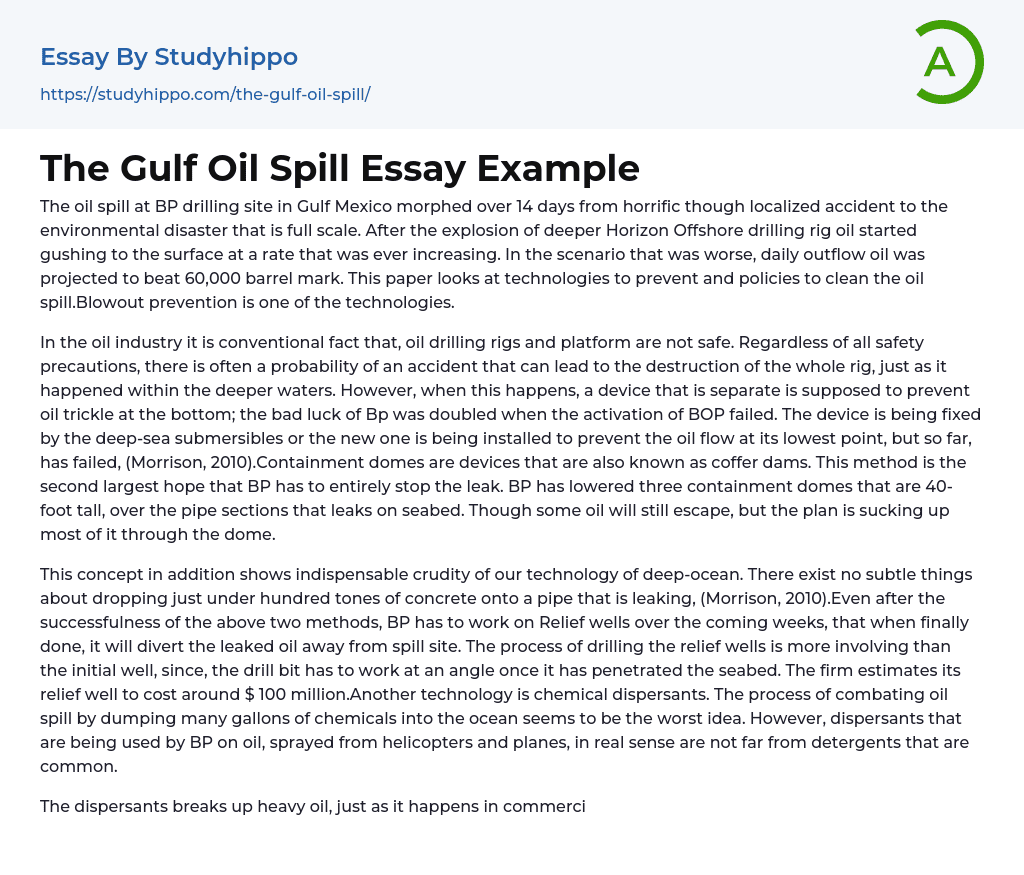The oil spill at the BP drilling site in the Gulf of Mexico rapidly transformed into a major environmental catastrophe from a localized incident. It originated from the explosion of the deeper Horizon Offshore drilling rig, resulting in an alarming surge of oil to the surface. The daily volume of oil being released was estimated to surpass 60,000 barrels during its peak. This paper concentrates on technologies and policies that aim to prevent and address oil spills, giving particular attention to blowout prevention.
The lack of safety in drilling rigs and platforms in the oil industry is widely recognized. Despite precautions, accidents can happen, resulting in potential destruction of the entire rig, especially in deeper waters. In such cases, a separate device called the BOP should prevent oil leakage at the bottom. Unfortunately f
...or BP, their misfortune doubled when the activation of the BOP failed. Attempts are being made to fix or replace this device using deep-sea submersibles, but these efforts have been unsuccessful so far (Morrison, 2010). BP is also utilizing another device known as containment domes or coffer dams to stop the leak. These 40-foot tall domes are placed over the pipe sections on the seabed where leaks occur. While some oil may still escape, the goal is to capture most of it by sucking it up through the dome.
This concept also highlights the essential primitiveness of our deep-ocean technology. There is nothing subtle about dropping nearly 100 tons of concrete onto a leaking pipe (Morrison, 2010). Even after the success of the previous two methods, BP still needs to focus on Relief wells in the coming weeks. Once these relief wells are completed
they will redirect the leaked oil away from the spill site. The process of drilling these relief wells is more complex than the initial well drilling, as the drill bit must work at an angle once it reaches the seabed. The estimated cost for these relief wells is about $100 million. Another technology being utilized is chemical dispersants. The idea of combating an oil spill by dumping large quantities of chemicals into the ocean may seem like a terrible idea. However, the dispersants being used by BP on the oil, which are sprayed from helicopters and planes, are actually similar to common detergents.
The dispersants break up heavy oil, similar to how dishwasher liquids work in commercials. At the leak source, submersibles inject more dispersants into the oil as it jets out, preventing some of it from reaching the surface. Skimming systems can separate oil floating on water, allowing it to be siphoned out and even sold on the market like regular oil. Skimming devices can range from small to massive, but despite technological advancements, there is currently no skimming system large enough to handle a spill the size of the Gulf without months of work. Another method of cleaning oil spills is through the use of fire, which is the oldest known technology for oil cleaning. Fire is considered a quick solution as gasoline burns off rapidly, although it can also lead to explosions at times.
Contrarily, 'sweet crude' welling is a viscous and dense substance that poses challenges in achieving even combustion. Despite the Coast Guard's attempts to burn sufficient amounts of oil to prevent it from reaching Louisiana's coastline, this approach failed (Morrison, 2010).
Another method involves deploying booms and barriers, which do not clean up oil spills but act as floating obstacles to hinder oil spread. Nevertheless, these booms proved ineffective in rough seas where waves carried oil over them, despite an adequate supply brought by the Coast Guard. Microbes have also been utilized using trillions of them to consume petroleum. However, the degradation of oil by fungi, bacteria, and other organisms typically takes weeks, months or even years. The pace of this process is influenced by the availability of oil droplets; hence dispersants are employed to break down the oil.
According to Biello (2010), the availability of other nutrients such as phosphorus and nitrogen also affects it. The criticism of the policy of placing a moratorium on new Gulf drilling is a devastating blow to energy production in America. The addition of a six-month moratorium results in years of delay due to fierce competition for drill leases worldwide. The proposed changes in liability for new drilling activities may have serious consequences for oil companies (A Chilling Response to Gulf Oil Spill, 2010). This article has influenced my approach to energy use as it reminds me that as humans, we have been given the power over other things on earth and we must use them wisely while taking care of the environment. Considering the damage caused by oil spills and the environmental effects of petroleum energy, people should switch to environmentally friendly energy sources.
- Organic Chemistry essays
- Acid essays
- Calcium essays
- Chemical Bond essays
- Chemical Reaction essays
- Chromatography essays
- Ethanol essays
- Hydrogen essays
- Periodic Table essays
- Titration essays
- Chemical reactions essays
- Osmosis essays
- Carbohydrate essays
- Carbon essays
- Ph essays
- Diffusion essays
- Copper essays
- Salt essays
- Concentration essays
- Sodium essays
- Distillation essays
- Amylase essays
- Magnesium essays
- Acid Rain essays
- Agriculture essays
- Albert einstein essays
- Animals essays
- Archaeology essays
- Bear essays
- Biology essays
- Birds essays
- Butterfly essays
- Cat essays
- Charles Darwin essays
- Chemistry essays
- Dinosaur essays
- Discovery essays
- Dolphin essays
- Elephant essays
- Eli Whitney essays
- Environmental Science essays
- Evolution essays
- Fish essays
- Genetics essays
- Horse essays
- Human Evolution essays
- Isaac Newton essays
- Journal essays
- Linguistics essays
- Lion essays




